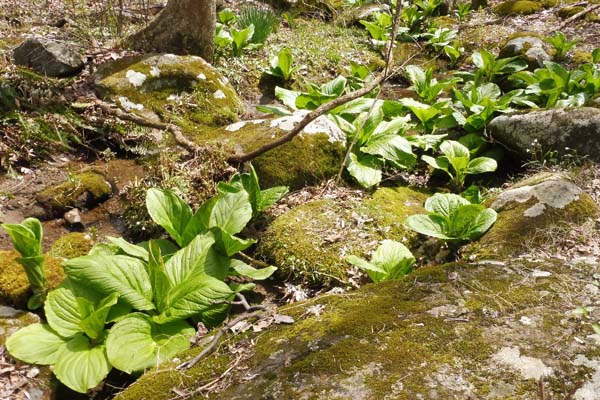Home Resources Gardener News reprints: Skunk cabbage
This article by Hubert Ling (NPSNJ horticulture) was published in Gardener's News without the photos. He is a regular contributing writer to Gardener's News. Photos by H & M Ling.Skunk cabbage

Skunk cabbage flower-clusters on the outside resemble a maroon and white speckled hoodie (spathe) with a twisted curved over hood. Inside the hood is an elongated spike (the spadix) which contains numerous very small male and female flowers clustered on the surface.
The entire plant is considered poisonous and contains large amounts of calcium oxalate. The name skunk cabbage originates from the odor which is like a mixture of skunk and garlic. The odor is much stronger if plant parts are crushed and odor from the flowers attracts carrion insects as well as stoneflies and bees. The plant is also of great interest to young children who often love gross things.

The plant is easy to grow in any mucky area with slightly acid to neutral soil. Propagation if so desired is easily accomplished by seed. The roots of skunk cabbage contract and pull the stem deeper in the muck each year so that old skunk cabbage plants are very difficult to dig up.
Swamp cabbage is one of the very few plants which can raise its temperature an astounding 63 °F above the ambient air. Even when submerged the flower temperatures can be 2 or 3 °F above the surrounding water. Having this elevated temperature may help the flowers poke through the ice and frozen mud. These warm flowers may also provide a favored resting place for carrion flies and other pollenating insects in an otherwise cold environment. This astounding feat perhaps explains why the plant can be the first in the north east to successfully bloom and be pollinated, and set seed at the end of winter before any other plant.
Although the plant is questionably listed as edible by some authors, wise fans of wild foods should listen to the admonition of Wildman Brill of NYC Central Park fame: “After cursing … for an hour before the burning and stinging of my tongue and mouth … subsided, I flushed the entire recipe… “. Calcium oxalate which feels like a thousand needles jabbing your tongue over and over is not broken down by cooking and it takes months to evaporate from thin areas of plant leaves. Leaves may be dried for 6-12 months after which Wildman states “it tastes like paper, which is a vast improvement!” In addition, moderately poisonous skunk cabbage is sometimes mistaken for the very poisonous false hellebore which frequently grows alongside skunk cabbage and also has large leaves in spring. Thus it is a little hard to understand why any sane person would attempt to eat skunk cabbage since it would be easier and safer to eat your Sunday newspaper.
Deer and other herbivores avoid skunk cabbage so it appears that the foul smell and toxic calcium oxalate protect the large, tempting leaves, which emerge in early spring. Although these leaves appear after the flowers, they still unfurl before almost any other plants. Bears appear to be about the only mammals to use skunk cabbage. It has been reported that about 75% of a bear’s stomach content in early spring is made up of skunk cabbage.
Although Native Americans made occasional use of skunk cabbage as food, after careful detoxification, skunk cabbage has been extensively used by natives and colonists as a medicinal plant. A tea from the roots and seeds has been used for treating asthma, convulsions, and since it is semi-toxic the Iroquois used it to remove parasitic worms. However, due to the toxicity it would be best to just enjoy skunk cabbage in place and pass along folklore and science about this amazing plant.